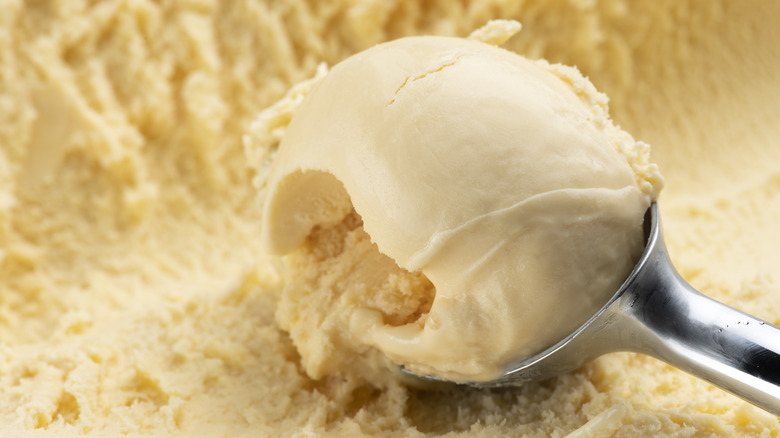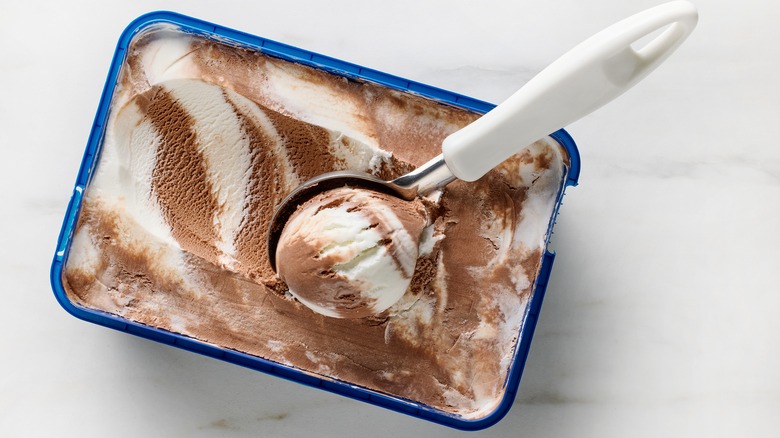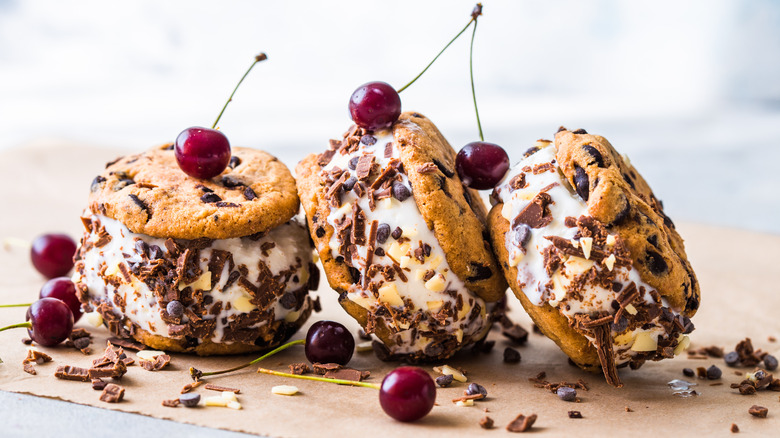How To Soften Ice Cream That's Too Frozen To Scoop
There's no greater frustration than diving into the freezer for your favorite ice cream, only to discover that it's frozen solid and you can't even dig a spoon into it. The ideal temperature for a freezer should be around -5 to 0 degrees Fahrenheit, but it's best to serve ice cream at around 6 to 10 degrees Fahrenheit, according to the International Dairy Foods Association. If you really have an urgent craving, there's a way to quickly soften up ice cream and get your fix faster.
While a clever hot knife hack can quickly soften ice cream, it doesn't create a consistent, creamy texture. Ice cream that's too melty in some spots can also be messy when you're intending to use it in desserts, like ice cream sandwiches. Another solution is to leave the carton of ice cream out on the counter for 10 to 15 minutes so that it's more scoopable, but that's no use if you're short on time. Softening the ice cream in the refrigerator does a nice, even job of defrosting it, but that can take even longer, with a wait time of up to half an hour.
Heating up ice cream in the microwave is the speediest method, but the risk is that the ice cream could melt unevenly, thawing around the edges while the center remains hard. However, simply reducing the power on your microwave can produce perfectly softened ice cream in no time, doing you a favor when you're in a hurry.
Microwave on lower power to soften ice cream fast
If you've ever tried to soften ice cream in the microwave before, you might've been disappointed with the inconsistent results. It's easy for it to turn soupy, or not soft enough. Lowering the power setting on your microwave, then only microwaving the ice cream in short bursts, is the key to quickly yet evenly softening your favorite frozen treat.
Adjust your microwave's settings to 30% power, then microwave a carton of ice cream for about 30 seconds. If you're defrosting a larger tub of ice cream, or you'd rather keep a closer eye on it, try going for 20 second bursts at 30% power. The reduced power setting works by pausing the microwave for brief periods, enabling the ice cream to thaw gently without melting too much.
However, be careful not to repeatedly soften and re-freeze the sweet treat over and over if you want to avoid crystallized, freezer-burned ice cream. If you're not planning to eat the whole carton immediately, then try another way to use up the ice cream, such as turning it into another dessert that can be re-frozen for later, or just by inviting some friends over.
How to use softened ice cream in tasty frozen desserts
One of the simplest yet most satisfying ways to use up ice cream is an ice cream sandwich. It's easy to spread softened ice cream on top of cookies for a homemade "cookiewich," or use brownies instead for more classic rectangular sandwiches with a chocolatey base.
For a fast and fuss-free ice cream pie, try layering softened ice cream into a pre-made cookie crust. Top with nuts, caramel or chocolate, and anything else you please, then freeze before slicing and serving. Alternatively, you could use spare ice cream to make a nostalgic ice cream cake; pile it into a sundae with fruit, caramel, or chocolate sauces; or blend it into a thick milkshake.
Once it's been softened, ice cream can become a versatile ingredient to transform any number of sweet dishes. And with the low-power microwave method, ice cream treats can be on your plate faster than ever, whenever the craving strikes.



